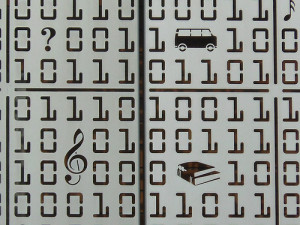New course combines “physical computing with artistic sensibilities”
 Through a new bi-discipline course, Interactive Art, professors Joel Hollingsworth and Michael Fels, of the computer science and art departments respectively, are exploring the ways in which art and programming can communicate and work together effectively.
Through a new bi-discipline course, Interactive Art, professors Joel Hollingsworth and Michael Fels, of the computer science and art departments respectively, are exploring the ways in which art and programming can communicate and work together effectively.
Hollingsworth and Fels connected a few years ago, when Fels wanted to use computer programming to add another layer to his art. Satisfied with their collaboration and interested in how programming and art could work together, Fels and Hollingsworth started to develop a course that could explore the connection.
Art and computing collide
Interactive Art teaches students use computer code to create interactive elements to traditional artistic pieces. As Hollingsworth describes it, the intent is to connect “physical computing with artistic sensibilities.”
“We are essentially trying to merge sculpture-type art with physical computing,” Hollingsworth said. “We are taking the time to teach how to do sensing, or how their art can sense light or movement of people. Then, we work on output for [such things as] motors spinning or sounds happening. We want to teach students how to express themselves in an artistic sense.”
To help with that process, the class uses the electronics prototype platform Arduino, which allows the students to write the code for the programs that will make their art pieces interact with viewers. While a majority of the students have never done coding before, Hollingworth said hey get the fundamentals of the process and are quickly learning.
Classroom dynamics
Art and computer science are courses that require different teaching styles, which could have complicated how the course runs. However, Hollingsworth believes he and Fels’ different perspectives benefit the classroom dynamic.
“[Working with Fels] has been great,” Hollingsworth said. “It’s interesting that we complement each other very well. When we talk to the students, we give them slightly different viewpoints, which I think helps students quite a bit.”
The students’ objectives
While the class does include both art and computer science majors, many of the participants are undecided first years who took the class out of curiosity. However, Hollingsworth said that the students, no matter their experience with either discipline, have taken to the course’s material.
“They seem to be doing well,” Hollingsworth said. “The students really like building things. In a lot of classes, you don’t physically build things, but these students are in the woodshop, building structures and embedding electronics in structures. We haven’t completed, [the course] yet, but we’re very interested to see how it turns out.”
Currently, the students are working in groups to create interactive art pieces that will be part of the arts and science walk showcased in and around Arts West during Celebrate week. Some examples of their projects are paintings that interact with viewers when they’re touched and a tree that responds to a person’s presence.
“Michael and I are interested that the student form technical and artistic side see how they merge together into one,” Hollingsworth said. “They can’t just do the technical or the art. It’s about the relationship of how it works together. As [the students] move forward into what they’re going to do, we hope they’re thinking about different aspects coming together and how that can be done in other fields [besides art and computer science].”
Looking to the future of interactive art
While the results of the inaugural Interactive Arts course have yet to be seen, Fels and Hollingsworth already have the course ready to be offered next spring. From there, they will see whether or not it is something they should continue to offer to their students. But for now, they remain hopeful of this course’s influence and longevity.
Image via Flickr user mikecogh / CC BY-SA 2.0
 Follow
Follow

